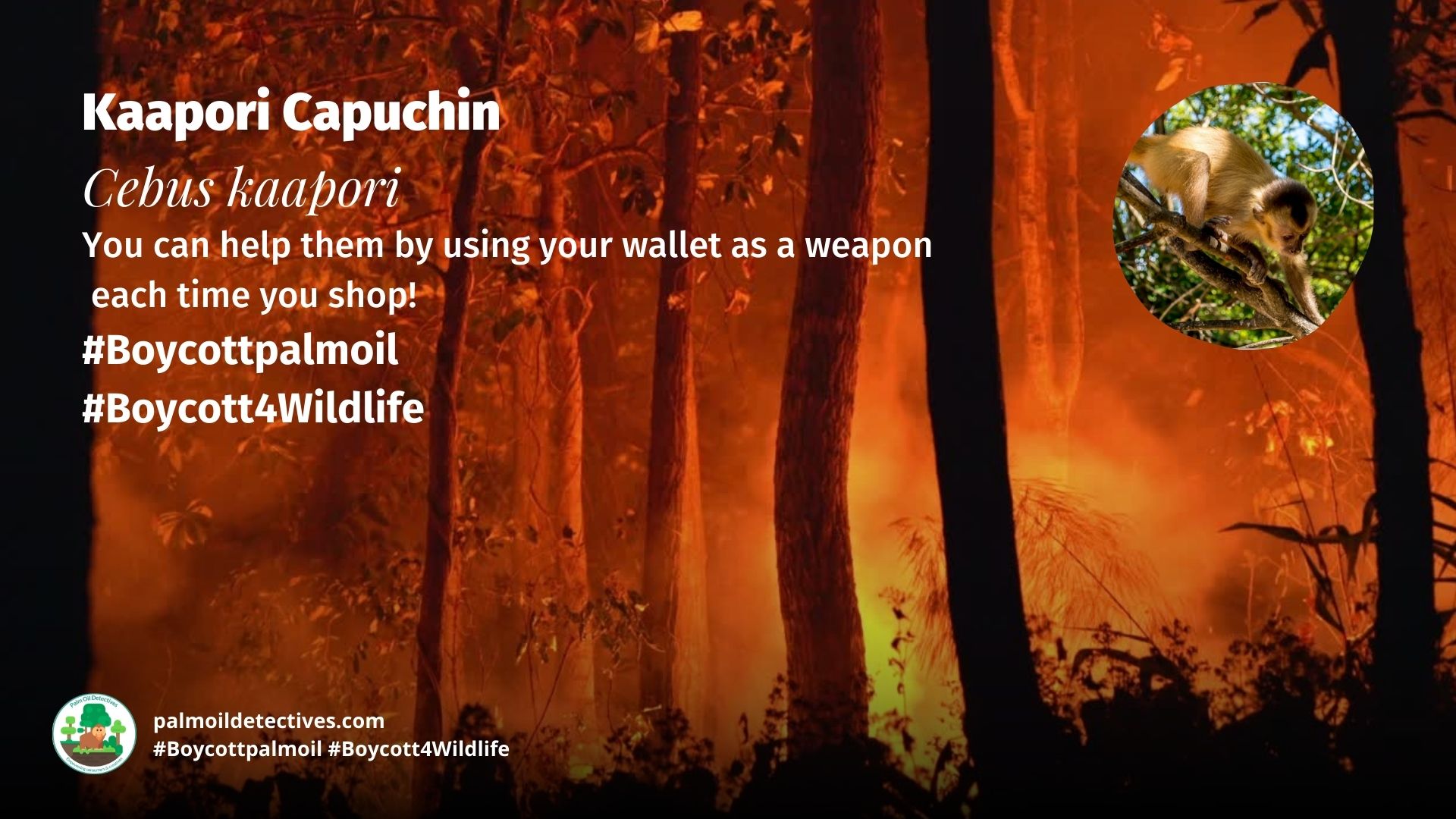Kaapori Capuchin Cebus kaapori
Critically endangered
Extant (resident)
Brazil (Pará, Maranhão)
The Kaapori capuchin is on a knife-edge of survival – they are critically endangered. In 2017 their population had been decimated by 80% due to deforestation for agriculture including soy, cattle grazing and palm oil. They are forgotten animals with no formal protections in place. Fight for them every time you shop and be #vegan #Boycottpalmoil #Boycott4Wildlife
Kaapori #capuchins are on the edge of #extinction. #Criticallyendangered by #hunting #palmoil #soy #cattle #deforestation in #Brazil. Say no to #palmoil #deforestation with your wallet and #Boycottpalmoil #Boycott4Wildlife
Tweet
Kaapori #capuchins of #Brazil are critically endangered from #corporate #greed for #meat #palmoil and #soy. They have no protections in place. Help them every time you shop and be #vegan, #Boycottpalmoil #Boycott4Wildlife
Tweet
Appearance & Behaviour
Part of the gracile genus of capuchin monkeys, Kaapori (also known as ka’apor) capuchins have longer limbs in comparison to their body size. They weigh around 2-3 kilos. Compared to other capuchin species, they have rounder skulls and musculature supporting their teeth and jaws means that they can’t open hard nuts. To get at insects living inside of trees they break branches with their teeth and hands in order to reach the ants inside. They also smash snails against trees in order to crack their shells open.

Threats
The Kaapori capuchin is on a knife-edge of survival – they are critically endangered. In 2017 their population had been decimated by 80% due to deforestation for agriculture including soy, cattle grazing and palm oil.
This species of capuchin is sensitive to even minor changes to their habitat. In the late 70’s the largest hydroelectric dam was built within their habitat range, flooding in the area left their forest home fragmented.
Just like every other primate species in South America – hunting and poaching is also a threat.


Kaapori Capuchins have no formal protections in place. You can help them by boycotting meat and palm oil which is resulting in habitat loss in their rainforest home. #Boycottpalmoil #Boycottmeat and #Boycott4Wildlife

Habitat
The Kaapori capuchin (also known as the Ka’apor capuchin) and is found in only one part of Brazil: Pará and Maranhão along the Atlantic coast to the north of the country.
They are normally found deep in the dense forest where food is most abundant, although they are also found in secondary growth areas during the dry season.
Diet
The Kaapori capuchin is most active during the day time and they are arboreal and omnivorous, feeding on fruits and small insects and invertebrates like snails, spiders, wasps, ants, catepillars, grasshoppers and when the opportunity strikes – bird eggs.
Mating and breeding
Kaapori capuchins are polygamous and females give birth to only one infant at a time with twins being rare. Their gestation period lasts about 150-180 days and they give birth around every two years, sometimes births come closer together when infants die. The capuchins are found in small groups of around 10 or less individuals and co-exist and live alongside bearded sakis and robust capuchins.
Ka’apor capuchins have no formal protections in place and they need your help.
If you wish to raise your voice for Ka’apor Capuchins, join the #Boycott4Wildlife.
You can support this beautiful animal
There are no known formal conservation activities in place for this animal. Make sure that you #Boycottpalmoil and #Boycott4Wildlife in the supermarket and raise awareness of the plight of beautiful animals in order to support their survival! Find out more here
Further Information
Fialho, M.S., Jerusalinsky, L., Moura, E.F., Ravetta, A.L., Laroque, P.O., de Queiroz, H.L., Boubli, J.P. & Lynch Alfaro, J.W. 2021. Cebus kaapori (amended version of 2020 assessment). The IUCN Red List of Threatened Species 2021: e.T40019A191704766. https://dx.doi.org/10.2305/IUCN.UK.2021-1.RLTS.T40019A191704766.en. Accessed on 12 September 2022.
Kaapori Capuchin on Wikipedia.
Kaapori Capuchin on Animalia.bio


How can I help the #Boycott4Wildlife?
Contribute in five ways
1. Join the #Boycott4Wildlife on social media and subscribe to stay in the loop: Share posts from this website to your own network on Twitter, Mastadon, Instagram, Facebook and Youtube using the hashtags #Boycottpalmoil #Boycott4Wildlife.
2. Contribute stories: Academics, conservationists, scientists, indigenous rights advocates and animal rights advocates working to expose the corruption of the palm oil industry or to save animals can contribute stories to the website.
3. Supermarket sleuthing: Next time you’re in the supermarket, take photos of products containing palm oil. Share these to social media along with the hashtags to call out the greenwashing and ecocide of the brands who use palm oil. You can also take photos of palm oil free products and congratulate brands when they go palm oil free.
4. Take to the streets: Get in touch with Palm Oil Detectives to find out more.
5. Donate: Make a one-off or monthly donation to Palm Oil Detectives as a way of saying thank you and to help pay for ongoing running costs of the website and social media campaigns. Donate here








One thought on “Kaapori Capuchin Cebus kaapori”